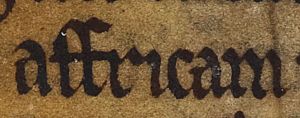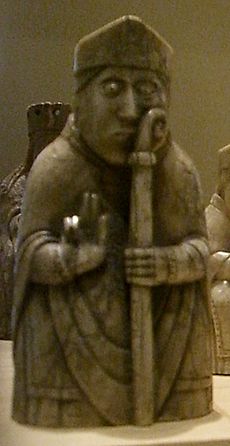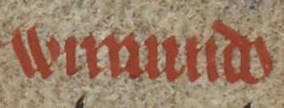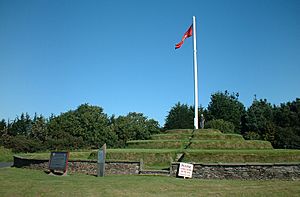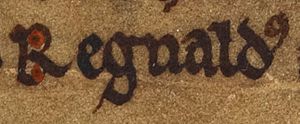Óláfr Guðrøðarson (died 1153) facts for kids
Quick facts for kids Óláfr Guðrøðarson |
|
|---|---|
| King of the Isles | |

Óláfr's name and title as it appears on folio 35v. of British Library Cotton Julius A VII (the Chronicle of Mann): "Olavus rex".
|
|
| Reign | 1112/1115–1153 |
| Predecessor | Domnall mac Taidc |
| Successor | Guðrøðr Óláfsson |
| Died | 29 June 1153 Mann |
| Wives |
|
| Issue | sons Guðrøðr, Rǫgnvaldr, Lǫgmaðr, and Haraldr; several daughters including Ragnhildr |
| House | Crovan dynasty |
| Father | Guðrøðr Crovan |
Óláfr Guðrøðarson (died 29 June 1153) was a powerful king in the 1100s. He ruled the Kingdom of Mann and the Isles, which included the Isle of Man and the Hebrides islands. Óláfr was a younger son of Guðrøðr Crovan, a famous king.
After his father died, Óláfr's older brothers fought for power. Young Óláfr was sent to live at the court of Henry I, King of England. Like other kings of his time, Óláfr was helped by the English king. As King of the Isles, Óláfr made important marriage alliances with rulers nearby. He also worked to modernize his kingdom.
Óláfr ruled for about 40 years. His reign ended suddenly in 1153 when his nephews killed him. After his death, Óláfr's son, Guðrøðr, became the new King of the Isles. Óláfr's family ruled the Isles for over a century.
Contents
A Kingdom in Chaos
The Isles were a group of islands that included the Hebrides and the Isle of Man. Óláfr's father, Guðrøðr Crovan, ruled these islands for more than 20 years. He died in 1095. His oldest son, Lǫgmaðr, took control.
Soon, fighting broke out between Lǫgmaðr and his younger brother, Haraldr. This led to other powerful groups from Ireland getting involved. After a short time, the region fell into more conflict. Magnús Óláfsson, King of Norway took advantage of this. He led two military campaigns in the Isles and the Irish Sea area. Magnús controlled these regions until he died in 1103. After his death, the Isles became chaotic again.
Óláfr's Rise to Power
King Henry I of England did not want Irish rulers to take over the Isles. So, he helped Óláfr become king between 1112 and 1115. This was around the time Domnall mac Taidc moved from the Isles back to Ireland.
Óláfr spent his youth at Henry I's court. His later actions show he was greatly influenced by his English upbringing. He founded Rushen Abbey, a religious house on the Isle of Man. He also helped create the Diocese of the Isles. This church area showed the borders of his kingdom.
Óláfr had at least two wives. His first wife was Ingibjǫrg, daughter of Hákon Pálsson, Earl of Orkney. His second wife was Affraic, daughter of Fergus, Lord of Galloway. These marriages show that Óláfr changed his alliances. He moved from an alliance with Orkney to one with Galloway. Later, one of Óláfr's daughters married Somairle mac Gilla Brigte, Lord of Argyll. Somairle was a rising power in the region.
Family Background
Óláfr was part of the Crovan dynasty. His father was Guðrøðr Crovan, who was King of Dublin and the Isles. Óláfr's brothers included Lǫgmaðr and Haraldr. Their father became King of the Isles in the late 1070s. He took control of Dublin in the early 1090s.
In 1094, Guðrøðr Crovan was forced out of Ireland by Muirchertach Ua Briain. Guðrøðr Crovan died on Islay the next year. He might have been driven from the Isle of Man too.
The Chronicle of Mann says that Lǫgmaðr, Óláfr's oldest brother, became King of the Isles. The chronicle also says Lǫgmaðr faced opposition from his brother Haraldr. Lǫgmaðr defeated Haraldr and punished him severely. After this, Lǫgmaðr faced more opposition from people who supported Óláfr.

Óláfr's supporters asked Muirchertach to provide a temporary ruler for the Isles. This ruler would govern until Óláfr was old enough. Muirchertach put his nephew, Domnall mac Taidc, on the throne. Domnall's rule was short. He seems to have lost control by 1097.

In 1097, Magnús Óláfsson, King of Norway sent a man named Ingimundr to take control of the Isles. But Ingimundr was killed by local leaders. The next year, Magnús himself invaded the area. He took control of the Isles and captured Lǫgmaðr. Magnús also campaigned against the English in Anglesey. He gained control of Galloway and made a treaty with Edgar, King of Scotland.
Magnús stayed in the Isles for the winter. He returned to Norway in the summer. He came back to the region in 1102 or 1103. Magnús made an alliance with Muirchertach by marrying his young son, Sigurðr, to Muirchertach's daughter, Bjaðmunjo. Magnús was killed in Ulster in 1103. Sigurðr immediately returned to Norway. Magnús's death left a power vacuum in the Isles.
Óláfr's Return and English Ties
The Chronicle of Mann says that Lǫgmaðr later regretted his cruelty to Haraldr. He gave up his kingdom and went on a crusade to Jerusalem, where he died. It is not clear which crusade he joined.
It's possible Lǫgmaðr joined Sigurðr's expedition to Holy Land in the early 1100s. If so, Óláfr might have been sent to Henry I's court around this time. The chronicle clearly states that Óláfr was raised at the English court. Henry I was likely seen as the only one who could keep Óláfr safe.
An ancestor of Óláfr, Óláfr kváran, was a king in the 900s. He might have been the inspiration for a literary character called Havelok the Dane. Óláfr's stay at Henry I's court may have led writers to create stories about his famous ancestor.

The exact date Óláfr became king is not known. The chronicle says he began to rule in 1102 and reigned for 40 years, dying in 1153. This means he likely became king around 1112 to 1115. This was when Muirchertach's power in Ireland began to weaken.
Henry I likely helped Óláfr return to the Isles. He wanted a loyal ruler in this important region. The English and Scottish kings probably worked together to prevent Irish influence in the Isles. Henry I may have wanted to expand English power in the Irish Sea.
Important Alliances
| Simplified family tree showing how Óláfr was related to Henry I, Fergus, and Somairle. | ||||||||||||||||||||||||||||||||||||||||||||||||||||||||||||||||||||||||||||||||||||||||||||||||||||||||||||||||||||||||||||||||||||||||||||||||||||||||||||||||||||||||||||||||||||||||||||||||||||||||||||||||||||||||||||||||||||||||||
|---|---|---|---|---|---|---|---|---|---|---|---|---|---|---|---|---|---|---|---|---|---|---|---|---|---|---|---|---|---|---|---|---|---|---|---|---|---|---|---|---|---|---|---|---|---|---|---|---|---|---|---|---|---|---|---|---|---|---|---|---|---|---|---|---|---|---|---|---|---|---|---|---|---|---|---|---|---|---|---|---|---|---|---|---|---|---|---|---|---|---|---|---|---|---|---|---|---|---|---|---|---|---|---|---|---|---|---|---|---|---|---|---|---|---|---|---|---|---|---|---|---|---|---|---|---|---|---|---|---|---|---|---|---|---|---|---|---|---|---|---|---|---|---|---|---|---|---|---|---|---|---|---|---|---|---|---|---|---|---|---|---|---|---|---|---|---|---|---|---|---|---|---|---|---|---|---|---|---|---|---|---|---|---|---|---|---|---|---|---|---|---|---|---|---|---|---|---|---|---|---|---|---|---|---|---|---|---|---|---|---|---|---|---|---|---|---|---|---|---|---|---|---|---|---|---|---|---|---|---|---|---|---|---|---|
|
||||||||||||||||||||||||||||||||||||||||||||||||||||||||||||||||||||||||||||||||||||||||||||||||||||||||||||||||||||||||||||||||||||||||||||||||||||||||||||||||||||||||||||||||||||||||||||||||||||||||||||||||||||||||||||||||||||||||||
Óláfr married Affraic, the daughter of Fergus, Lord of Galloway. This marriage likely happened in the 1130s or 1140s. Affraic was the mother of Óláfr's son, Guðrøðr. This marriage gave Óláfr's family important connections with the English king. Fergus also benefited, gaining protection from Óláfr's strong fleet.
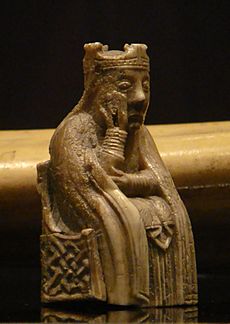
Óláfr also had dealings with Furness Abbey, a religious house. This suggests he had good relations with Stephen of Blois, who founded the abbey. Around 1140, Somairle mac Gilla Brigte married one of Óláfr's daughters, Ragnhildr. These alliances with Fergus and Somairle may have been part of a Scottish plan. Scotland wanted to draw Óláfr into their influence.

Óláfr also had several daughters and three sons from other relationships. These sons were Rǫgnvaldr, Lǫgmaðr, and Haraldr. Óláfr also married Ingibjǫrg, daughter of Hákon Pálsson, Earl of Orkney. This marriage likely happened before his marriage to Affraic. Óláfr seems to have shifted his alliances from Orkney to Galloway. The chronicle says Óláfr had peaceful alliances with Irish and Scottish kings. No one "dared disturb" the Kingdom of the Isles.
Church and Kingdom
Óláfr likely met members of the Scottish royal family while at the English court. He was influenced by Henry I's efforts to reform the English Church. Óláfr brought new religious orders to his kingdom. The Chronicle of Mann says he was "devout and enthusiastic in matters of religion."
The church area in Óláfr's kingdom was the Diocese of the Isles. Its borders likely matched his kingdom. In 1134, Óláfr founded Rushen Abbey on the Isle of Man. This was the first reformed religious house in the Isles. It showed the strong connection between Mann and northern England.

Óláfr gave the monks of Furness the right to choose the Bishop of the Isles. This showed his royal power. It also allowed Furness to bring new ideas into the Isles. The charter suggests that outside bishops had been controlling the church in the Isles. Óláfr wanted his own bishop.
Óláfr's next bishop was Wimund, Bishop of the Isles. Wimund started at Furness before moving to Rushen. He seems to have been the first bishop chosen by the Furness monks. Wimund later used his position to fight for land in the late 1140s. His actions likely caused problems for Óláfr's rule.
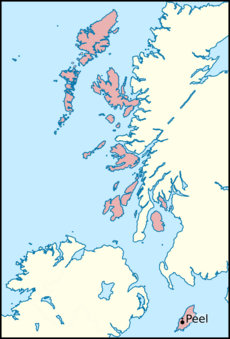
Óláfr eventually seemed to reject Wimund. He tried to get a new bishop, Nicholas, consecrated. But he was unsuccessful. In 1152, a Benedictine monk named John was consecrated as Bishop of the Isles. But the Chronicle of Mann does not list John. This suggests he was not accepted by Óláfr or the people of the Isles.
Protecting the Kingdom
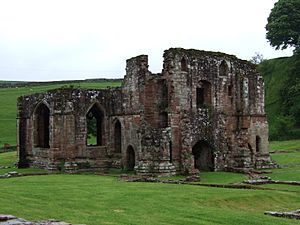
Óláfr's actions helped define the borders of his kingdom through the church. He also tried to shift the church's loyalty from Canterbury to York. This would further distance his diocese from Dublin. In 1152, Dublin's church was becoming more powerful. Óláfr worried that his bishop would become controlled by Dublin. This would weaken his power.
It was during this time that Óláfr's son, Guðrøðr, traveled to Norway in 1152. Guðrøðr likely went to get help from a powerful church leader there. This leader would protect the Diocese of the Isles. Guðrøðr's visit happened when a papal representative, Nicholas Breakspeare, was in Scandinavia. Nicholas was creating new church provinces.
One of these new provinces was the Archdiocese of Niðaróss in Norway. The Diocese of the Isles was officially included in this province in 1154. Óláfr did not live to see this. But his and Guðrøðr's efforts protected their kingdom's independence from Dublin. The new Norwegian archdiocese tied the Norse territories closer to Norway.
Óláfr's Rule
Óláfr's rule can be compared to that of David I, King of Scotland. Both kings modernized their kingdoms. Óláfr introduced new systems of land ownership on Mann. He also brought the parochial system to the Isles. Like David I, Óláfr changed the church in his kingdom. He created a diocese with clear borders.
The election of a king was important in northern Europe. Leaders played a big role in choosing the King of the Isles during Óláfr's time. For example, leaders helped arrange for a temporary ruler until Óláfr was old enough. After Óláfr's death, the leaders of the Isles chose Guðrøðr as king.
Only one royal charter from Óláfr's reign still exists. In it, Óláfr called himself rex insularum (King of the Isles). This was a Latin version of a Gaelic title. Óláfr was the first king from his family to claim to rule "by the grace of God." This phrase was common among European monarchs. Óláfr used it to show his right to be king. It also showed he was a new kind of ruler.

Óláfr was an active king. He strengthened his rule in the northern part of the Isles using military force. He may have been helped by Somairle in these battles. Some sources say Óláfr also campaigned on North Uist. This suggests that Somairle helped Óláfr gain control of these territories.
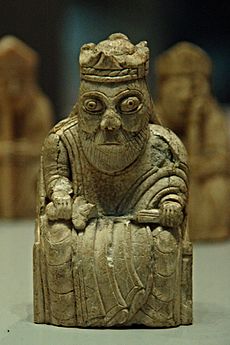
The Kingdom of the Isles may have lost control of areas in Galloway during Óláfr's reign. The installation of a new bishop in Whithorn in the 1120s might mark when Galloway separated from the Isles. Although Óláfr's reign is described as peaceful, other sources mention Wimund's fighting. This suggests Óláfr may have struggled to control his large kingdom.
Óláfr's Death
The year 1153 was a turning point for the Kingdom of the Isles. David I, King of Scotland died in May. Óláfr himself was killed about a month later, on June 29. His son Guðrøðr was still in Norway.
According to the Chronicle of Mann, Óláfr was confronted by three nephews from Dublin. They were the sons of his exiled brother, Haraldr. These nephews demanded half of the kingdom. During a meeting, one of them, Rǫgnvaldr, approached Óláfr. He raised his axe and killed the king with one blow.
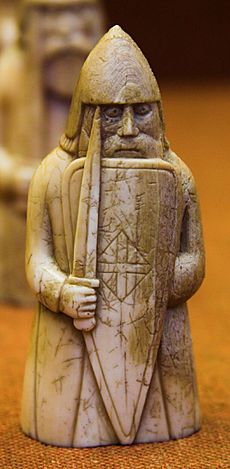
After Óláfr's death, his nephews divided the Isle of Man among themselves. They tried to protect themselves from Guðrøðr's loyal forces. They attacked Guðrøðr's grandfather, Fergus, in Galloway. The invasion was pushed back. When the nephews returned to Mann, they killed or expelled all people from Galloway. This was an attempt to remove anyone loyal to Guðrøðr and his mother.
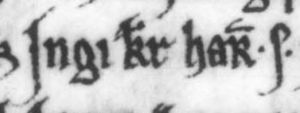
Within months, Guðrøðr returned from Norway. He had Norwegian military support. The leaders of the Isles chose him as king. He went to Mann and defeated his three cousins. He killed one and blinded the other two. Guðrøðr successfully secured the kingship for himself.
Óláfr sent Guðrøðr to Norway in 1152 because he was worried about who would rule next. Guðrøðr likely pledged loyalty to Ingi Haraldsson, King of Norway to get help. The chronicle says Guðrøðr returned with five ships, showing he got overseas support. The constant fighting for the kingship shows how competitive and violent it was.
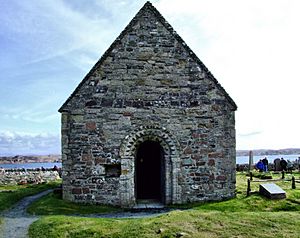
Through Guðrøðr, Óláfr was an ancestor of later rulers of the Crovan dynasty. This family ruled the Isles until the late 1200s. Through his daughter Ragnhildr, Óláfr was also an important ancestor of the rulers of Clann Somairle. These were the descendants of Ragnhildr's husband, Somairle.
Óláfr's burial place is unknown. However, Rushen Abbey became the burial place for the Crovan dynasty. Guðrøðr was buried on Iona. St Oran's Chapel on Iona is the oldest intact building there. It may have been built by Óláfr or Guðrøðr.
Images for kids
-
The name of Domnall mac Taidc as it appears on folio 33v of British Library Cotton Julius A VII (the Chronicle of Mann): "Dompnaldum filium Tadc".
-
The name and title of Magnús Óláfsson as it appears on folio 46v of Oxford Bodleian Library Rawlinson B 489 (the Annals of Ulster).
-
The name of Lǫgmaðr Guðrøðarson as it appears on folio 33v of AM 47 fol (Eirspennill): "Lǫgmaðr het son Guðrǫðar Suðr eyia konvngs". The excerpt describes Lǫgmaðr as the son of Guðrøðr Crovan, king of the Suðreyjar—an Old Norse term meaning "Southern Islands", roughly equating to the Hebrides and Mann.
-
The name and title of Muirchertach Ua Briain as it appears on folio 19r of Oxford Bodleian Library Rawlinson B 488 (the Annals of Tigernach): "Muirchertaigh h-Úi Bríain, ríg Muman". Under Muirchertach, the Irish Uí Briain kindred sought to extend its influence into the Isles.
-
A queen gaming piece of the so-called Lewis chessmen. Almost nothing is known of queenship in the Isles.
-
The name of Óláfr's father-in-law, Hákon Pálsson, as it appears on folio 37r of AM 47 fol: "Hakon s(on) Pals j(arls)".
-
A bishop gaming piece, one of the so-called Lewis chessmen.
-
Ruinous Rushen Abbey, near Ballasalla. The actual abbey founded by Óláfr may have been located near Castletown, before removing to Ballasalla late in the twelfth century.
-
The name of Wimund as it appears on folio 122v of British Library Cotton Vespasian B VI (Historia rerum Anglicarum).
-
Extent of the Diocese of the Isles, c.1300.
-
Ruinous Furness Abbey. Óláfr forged close connections with the monks of this Lancashire religious house, and granted them the right to elect his Bishop of the Isles.
-
Tynwald Hill, near St John's may have been a national assembly site of the Kingdom of the Isles. It may well have been the place where the Islesmen publicly inaugurated their kings, proclaimed new laws, and resolved disputes. Nevertheless, much of the visible site dates only to the eighteenth-, nineteenth-, and twentieth century.
-
The name of Óláfr's daughter, Ragnhildr, as it appears on folio 143r of GKS 1005 fol (Flateyarbók): "Ragnhilldi". Ragnhildr married Somairle mac Gilla Brigte.
-
One of the king gaming pieces of the so-called Lewis chessmen.
-
The name and title of Ingi Haraldsson as they appear on folio 57v of AM 47 fol: "Ingi konvngr Haʀalldz s(on)".
-
A rook gaming piece of the so-called Lewis chessmen. The Scandinavian connections of leading members of the Isles may have been reflected in their military armament, and could have resembled that depicted upon such gaming pieces.
-
St Oran's Chapel, the oldest intact building on Iona, may have been built by Óláfr, his family, Somairle mac Gilla Brigte, or the latter's family.






